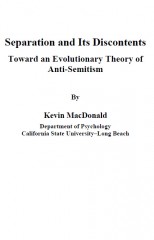
Author : MacDonald Kevin
Title : Separation and Its Discontents Toward an Evolutionary Theory of Anti-Semitism
Year : 2004
Link download : MacDonald_Kevin_-_Separation_and_Its_Discontents_Toward_an_Evolutionary_Theory_of_Anti-Semitism.zip
Preface to the First Paperback Edition. This is a reprint of the hardcover edition published originally in 1998 by Praeger, an imprint of Greenwood Publishing. The only changes are changes in formatting and pagination. There is little that I would like to change at this point. However, there are two issues that merit further discussion: psychological mechanisms of ethnic conflict and a reply to Paul Rubin. Rubin, an academic economist, published some negative comments on the ideas contained in Separation and Its Discontents in the journal Politics and the Life Sciences (Rubin 2000). These issues are discussed in the following. I am also continuing to publish material relevant to other themes raised in this book: Jewish ethnocentrism and self-deception (MacDonald 1998/2002; 2003a), the effectiveness of Jewish activism (MacDonald 2003a), anti-Semitism (MacDonald 2001, 2002a, 2002/2003), neo-conservatism as a Jewish intellectual movement (MacDonald 2003b), and an evolutionary perspective on Western culture (MacDonald 2002b). PSYCHOLOGICAL MECHANISMS OF ETHNIC CONFLICT Chapter 1 deals almost exclusively with social identity theory as a way of understanding ethnic relations. I have come to think that there are several mechanisms that are important; this Introduction attempts to rectify this gap. Ethnicity is not unique in calling for theoretical pluralism. Pluralism of mechanisms devoted to solving the same adaptive problem is common, especially, I suggest, for systems designed to solve problems with very high potential costs or benefits to the organism. For example, an adequate theory of aggression must include universal adaptations whereby aggression is triggered in specific contexts (e.g., sexual jealousy triggered by signs of infidelity; threat to an ingroup; certain types of aversive stimulation) (Berkowitz 1982; Buss 1999). However, we also need theories that can account for sex differences, individual differences, and group differences in aggression. These imply the importance of genetic and environmental influences on a variety of evolved systems, including temperament/personality systems associated with aggression (sensation seeking, impulsivity, and social dominance). Also implicated are emotionality (related to the tendency to exhibit anger and irritability) and sociopathy (related to the inability to experience the emotions of sympathy, empathy, and love MacDonald 1995a). Finally, learning mechanisms, such as being exposed to successful aggressive models, and cognitive mechanisms (e.g., tendencies to over-attribute hostile intent) have also been implicated in aggression (Coie & Dodge 1998). The following discusses four systems underlying the phenomenon of ethnic identity: social identity mechanisms, genetic similarity theory, a racial/ethnic human kinds module, and domain-general problem solving mechanisms. Social Identity Theory The first chapter of Separation and Its Discontents emphasized the fundamental importance of social identity theory for understanding ethnic conflict. I recently came across the following quotation from William Graham Sumner who, writing in 1913, expressed all of the essential ideas that have been verified by modern psychology: Loyalty to the group, sacrifice for it, hatred and contempt for outsiders, brotherhood within, warlikeness without—all grow together, common products of the same situation. It is sanctified by connection with religion. Men of an others-group are outsiders with whose ancestors the ancestors of the we-group waged war…Each group nourishes its own pride and vanity, boasts itself superior, exalts its own divinities, and looks with contempt on outsiders. Each group thinks its own folkways the only right ones, and if it observes that other groups have other folkways, these excite its scorn. (Sumner 1906, 13) As noted in Chapter 1, social identity research indicates that people in threatened groups develop a psychological sense of shared fate. The fact that social identity mechanisms appear to be highly sensitive to the presence of external threat to the group is compatible with supposing that people continue to track individual self-interest; in the absence of threat people are more individualistic, and in times of threat, group and individual interests increasingly coincide and group members increasingly have a shared fate. Shared fate in human groups is likely to occur during situations such as military conflicts and other examples of intense between-group competition in which defection is not individually advantageous or is not an option at all. In attempting to develop an evolutionary scenario for these processes, I suggest that warfare is the most likely candidate to meet these conditions. Warfare appears to have been a recurrent phenomenon among pre-state societies. Surveys indicate over 90% of societies engage in warfare, the great majority engaging in military activities at least once per year (Keeley 1996, 27–32). Moreover, “whenever modern humans appear on the scene, definitive evidence of homicidal violence becomes more common, given a sufficient number of burials” (Keeley 1996, 37). Because of its frequency and the seriousness of its consequences, primitive warfare was more deadly than civilized warfare. Most adult males in primitive and pre-historic societies engaged in warfare and “saw combat repeatedly in a lifetime” (Keeley 1996, 174). Shared fate would be likely in situations where potential defectors were summarily executed or severely punished by the ingroup, or in situations were survivors were summarily executed by a conquering outgroup or lost access to women and other resources. There is little evidence for high levels of discipline and coercion in pre-state warfare, although it occurred at least in some cases (Turney-High 1971). Nevertheless, cowards were often shamed and courage was a highly valued trait (Keeley 1996, 42–44; Turney- High 1971), so that defection from the fighting group did indeed have costs as a result of social pressure. More important perhaps is that the slaughtering of conquered peoples, especially males, has been a persistent feature of warfare. In their rise to power, the Aztecs probably “slaughtered those who opposed them, as all conquerors have always done” (Keegan (1993, 114). In pre-state warfare, while women were often taken as prizes of warfare, immediate death was often the fate of women and children and the certain fate of adult male prisoners: “Armed or unarmed, adult males were killed without hesitation in battles, raids, or the routs following battles in the great majority of primitive societies. Surrender was not a practical option for adult tribesmen because survival after capture was unthinkable” (Keeley 1996, 84). There is reason to suppose, therefore, that situations of intense betweengroup conflict have recurrently given rise to shared-fate situations. Moreover, Boehm (1997) shows that human hunter-gatherer groups are characterized by an “egalitarian ethic” for an evolutionarily significant period—long enough to have influenced both genetic and cultural evolution. The egalitarian ethic implies that meat and other important resources are shared among the entire group, the power of leaders is circumscribed, freeriders are punished, and virtually all important decisions are made by a consensus process. The egalitarian ethic thus makes it difficult for individuals to increase their fitness at the expense of other individuals in the same group, resulting in relative behavioral uniformity and relatively weak selection pressures within groups. Mild forms of social control, such as gossip and withholding social benefits, are usually sufficient to control would-be dominators, but more extreme measures, such as ostracism and execution, are recorded in the ethnographic literature. By controlling behavioral differences within groups and increasing behavioral differences between groups, Boehm argues that the egalitarian ethic shifted the balance between levels of selection and made selection between groups an important force in human evolution. Although social identity mechanisms are pan-human universals, Chapter 1 argues that Jews have an intense sense of group belonging that has sometimes resulted in martyrdom rather than leaving the group. Such individuals are extremely prone to a sense of shared fate to the point that defecting from the group is not a psychologically available option. Particularly striking is the account of Jewish martyrs during the Crusades of 1096, when men killed their families rather be converted to Christianity (see Ch. 1). Martyrdom as a response to being required to betray religious law is a recurrent theme of canonical Jewish religious writings, beginning with the “binding of Isaac” in Genesis (i.e., Abraham’s agreement with God’s command to sacrifice his son) and including several stories in the later portions of the Hebrew Bible (Isa:40–55; the story of Shadrach, Meshach, and Abednego in the Book of Daniel), the Apocrypha (e.g., the story of Hannah and her seven sons in IV Maccabees), the writings of Philo and Josephus, Midrashic commentaries, the Mishnah, and the Talmud (Agus 1988; Droge & Tabor 1992). Individual well-being in an afterlife was an important theme of these writings, but there was also an ideology that martyrdom under certain circumstances was critical to the success of the group,: “It was through the blood of these righteous ones, and through the expiation of their death, that divine Providence preserved Israel, which had been ill-used (IV Macc. 17:22). The discussion in the Babylonian Talmud (b. Sanhedrin 74a–75a) provides conflicting opinions, with one group holding that martyrdom is required to avoid committing transgressions involving idolatry, incest, adultery, and murder, while a stricter group held that if a Jew is publicly required to transgress any law no matter how trivial (including the Jewish custom of wearing white shoe straps rather than the black shoe straps worn by the Romans), “one must be martyred even for a minor precept rather than violate it.” Later, Maimonides (b. 1135) held that while heroic defiance of religious persecution was “a normative ideal” and a “legitimate and noble act” for the Jewish community (Halkin & Hartman 1985, 57, 66), transgressions performed to avoid martyrdom were not required except under certain circumscribed conditions and transgressors could remain members of the community despite past sins (Maimonides 1985, 25). Reflecting the collectivist tendencies of Judaism, Maimonides’ criterion for whether martyrdom or transgression was required was whether the community as a whole would be better off with one strategy or the other. There is no reason to suppose that such an extreme level of self-sacrifice is a pan-human psychological adaptation; not all of us are so deeply attached to our groups. Indeed, Europeans are much more prone to individualism and seem to generally lack the profound sense of group identity that is so characteristic of Jews (MacDonald 1998/2002). In any case, the existence of significant numbers of people for whom desertion from the group is not a psychologically available option shows that between-group selection must be presumed to have occurred among humans. Even so, the existence of such people is not a necessary condition for groups being a vehicle of selection. Even if all humans were entirely opportunistic and fickle in their group affiliations so that group membership was always contingent on individual self-interest, groups as a vehicle of selection would still be required in order to understand the behavior of coordinated groups (Wilson 2002). ...

Demolins Edmond - Saint Louis
Auteur : Demolins Edmond Ouvrage : Saint Louis Année : 19881 Lien de téléchargement :...














